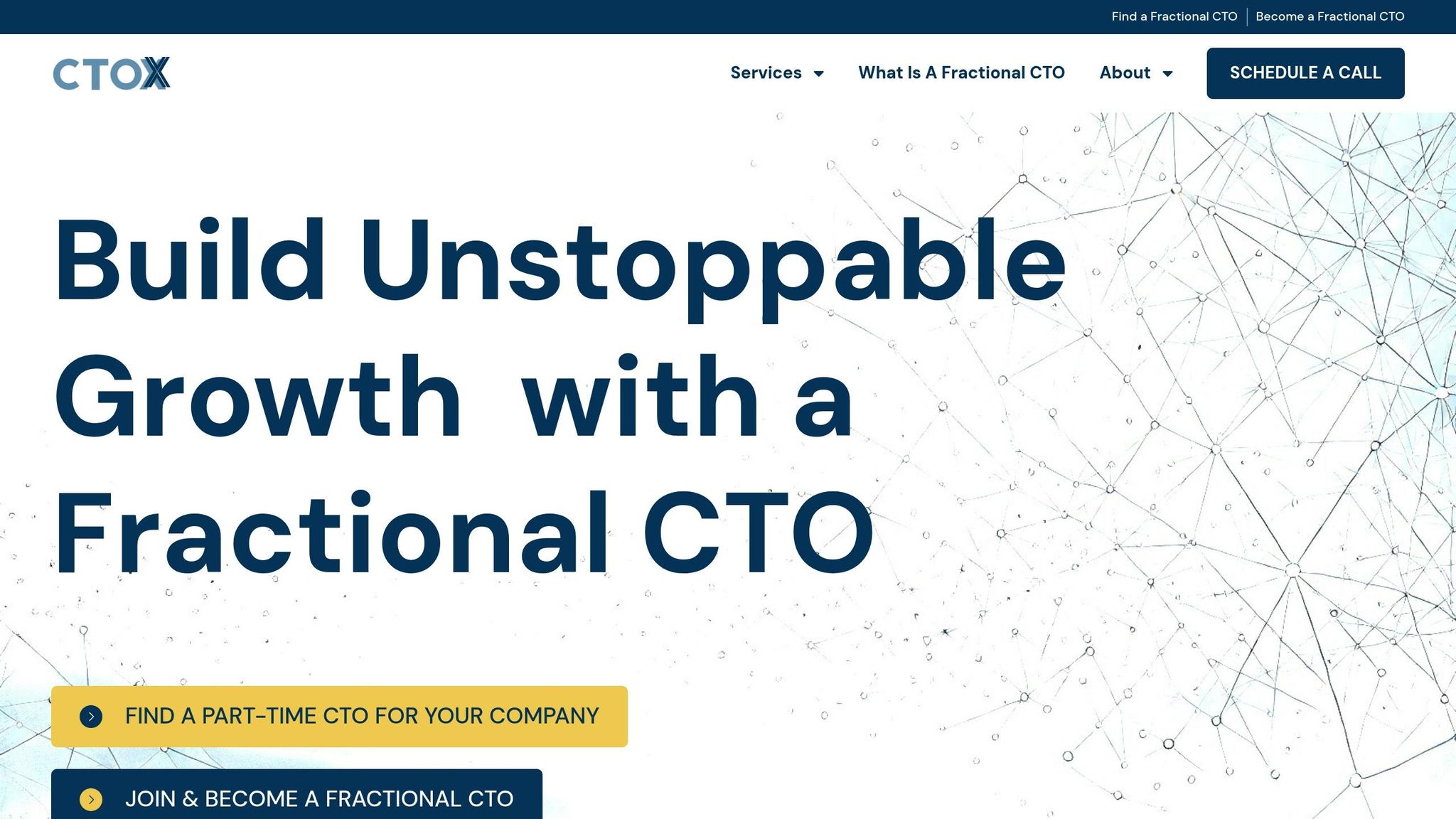Want to save money, improve efficiency, and drive growth? Aligning your IT strategy with business goals is the answer. Misaligned IT strategies waste resources and block progress, while proper alignment ensures:
- Better resource use
- Streamlined operations
- Cost reductions
- A strong foundation for growth
Key steps to align IT with business needs:
- Identify Business Goals: Focus on growth, efficiency, future tech needs, and cybersecurity.
- Audit IT Systems: Check infrastructure, performance, vendors, and security gaps.
- Set Clear Targets: Define IT goals tied to business outcomes (e.g., automation, scalability).
- Build Team Alignment: Regularly connect IT and business leaders to track progress.
- Monitor KPIs: Use scorecards to measure success and adapt as needed.
Need expert guidance? A fractional CTO offers part-time leadership to align tech with business goals, saving over $200k annually.
Keep reading for actionable steps, timelines, and tools to align your IT strategy effectively.
How do you align IT strategy with business goals?
Map Business Requirements
Start by aligning your organization’s goals with its IT capabilities. This ensures that technology investments directly support your objectives and deliver maximum return on investment.
List Key Business Goals
Identify the main objectives your technology needs to support. These might include growth, improving efficiency, driving new initiatives, or ensuring strong cybersecurity measures.
Key areas to focus on:
- Growth Goals: Define specific targets like revenue increases or entering new markets.
- Operational Efficiency: Highlight areas where processes can be streamlined or costs reduced.
- Future Technology Needs: Determine the tools and systems required to support upcoming projects or expansions.
- Cybersecurity and Compliance: Set clear priorities for data protection and meeting regulatory requirements.
"Our leaders bring a wealth of technical knowledge and strategic guidance customized to your industry, ensuring your technology aligns with your objectives for business growth." – CTOx
After listing these goals, evaluate your current IT systems to uncover gaps that could hinder progress.
Review IT Systems
Take a close look at your existing IT setup to identify areas that need improvement. This evaluation will help you decide where to focus your efforts and investments.
The review should include:
- Infrastructure Audit: Examine your systems and processes to ensure they can meet your growth plans. Look for areas where optimizations are possible.
- Performance Metrics: Use KPIs to monitor system performance and team productivity. This provides clear insights for making informed decisions.
- Vendor Review: Assess current vendors to eliminate redundant or underperforming services. This step often uncovers cost-saving opportunities and boosts system efficiency.
| Assessment Area | Key Considerations | Expected Outcomes |
|---|---|---|
| Infrastructure | Capacity, scalability, integrations | Readiness for growth |
| Security | Data protection, compliance, risks | Identification of security gaps |
| Efficiency | Automation, resource use, workflows | Cost-saving opportunities |
| Innovation | New technology, competitive edge | Plan for strategic improvements |
Build Team Alignment
For an IT strategy to succeed, IT and business teams must work together seamlessly. Establishing clear communication channels and shared goals ensures everyone is moving in the same direction.
Connect with Key Players
To bridge the gap between IT leaders and business stakeholders, set up structured communication and clearly define roles. For example, hold bi-weekly strategy meetings with IT leaders and business executives to assess team progress and address challenges. With these connections in place, align your team around specific, measurable objectives that benefit everyone.
Create Clear Goals
Using your business requirements as a foundation, outline goals that enhance IT operations while supporting business growth. Combine technical and business perspectives to create unified objectives.
| Goal Type | Business Focus | Technical Alignment |
|---|---|---|
| Strategic | Increase revenue | Build scalable systems |
| Operational | Reduce costs | Automate processes |
| Innovation | Expand market reach | Adopt emerging technologies |
| Risk Management | Ensure compliance | Strengthen security |
Write down measurable goals, define success metrics, and regularly evaluate progress to stay aligned with changing priorities.
"A fractional CTO provides strategic leadership on a part-time basis, collaborating with your existing technology team or managing outsourced functions. They focus on aligning technology strategies with business objectives, ensuring tech projects, no matter how big or small, contribute directly to your business goals."
To keep things on track, introduce routine KPI scorecards. These provide clear insights into performance, help monitor progress, and flag issues before they grow into bigger problems.
Build the IT Plan
Create an IT plan that connects your technical capabilities to your business goals. Think of it as your guide for driving growth.
Define IT Targets
Using your business needs as a foundation, set clear technology goals that deliver measurable results.
| Priority Area | IT Target | Business Impact |
|---|---|---|
| Infrastructure | Audit and upgrade outdated systems | Boost efficiency and cut costs |
| Security | Adopt a zero-trust architecture | Strengthen security and stay compliant |
| Automation | Introduce workflow automation tools | Increase productivity and simplify processes |
| Scalability | Shift to cloud-based solutions | Create a flexible base to support future growth |
Focus on both short-term wins and long-term goals. Start by auditing your systems within the first 90 days to identify gaps and opportunities. This will shape your technology roadmap.
Map the Timeline
Once you’ve set your IT targets, break your plan into manageable phases:
-
Assessment Phase (Weeks 1–4)
Review your current systems, analyze your tech stack, and find critical weaknesses. Document workflows and set baseline metrics. -
Planning Phase (Weeks 5–8)
Build detailed project plans, assign resources, and define KPIs. Set clear milestones and establish success benchmarks. -
Implementation Phase (Weeks 9–12)
Roll out priority projects while holding regular progress reviews. Track KPIs and make adjustments as needed.
sbb-itb-4abdf47
Put the Plan in Action
Implement your IT strategy in line with your business goals.
Launch IT Projects
Begin by focusing on projects that offer the most value to your business. Prioritize initiatives that directly contribute to achieving your key objectives.
| Project Phase | Key Activities | Success Metrics |
|---|---|---|
| Initial Setup | Team assignments, resource allocation, tool setup | Project readiness score |
| Development | Iterative builds, quality testing, stakeholder reviews | Sprint velocity, code quality |
| Deployment | User training, system migration, performance monitoring | System uptime, user adoption |
| Optimization | Performance tuning, process refinement, feedback loops | Response times, efficiency gains |
Make sure there’s clear ownership of responsibilities. Tech leadership should:
- Provide development teams with the necessary tools and resources
- Keep communication open between IT and business units
- Schedule regular progress updates with stakeholders
- Prepare contingency plans for potential challenges
After launching projects, keep a close eye on progress to ensure they stay aligned with business goals.
Track and Update
Use a reliable tracking system to monitor progress and maintain alignment with your objectives. Regular checks help catch problems early and make quick adjustments possible.
Here are some key practices:
- Weekly Progress Reviews: Hold team meetings to review status and resolve issues.
- Monthly KPI Scorecards: Monitor critical metrics linked to business outcomes.
- Quarterly Strategy Alignment: Reassess IT initiatives to adapt to changing business needs.
Develop a dashboard to track both technical and business metrics. Important areas to measure include:
- Project timelines and completion rates
- Budget use and return on investment
- System performance indicators
- User adoption levels
- Overall business impact metrics
Solve Common Problems
When aligning IT strategy with business goals, organizations often face several tough challenges. Here’s a breakdown of the most common issues and practical ways to address them.
Key Issues to Watch For
Alignment problems typically fall into these categories:
| Challenge Area | Common Issues | Business Impact |
|---|---|---|
| Strategic Planning | Misaligned tech priorities, unclear goals | Wasted resources, missed opportunities |
| Communication | Gaps between IT and business teams, confusing jargon | Delayed projects, misunderstood needs |
| Infrastructure | Outdated systems, incompatible tools | Lower efficiency, higher maintenance costs |
| Resource Management | Lack of expertise, tight budgets | Stifled innovation, operational slowdowns |
How to Fix These Problems
To tackle these challenges, focus on practical steps that directly address misalignments:
-
Strategic Leadership
Appoint strong tech leadership, such as a fractional CTO, who can guide strategy and conduct regular reviews to identify and remove inefficiencies. -
System Audits
Conduct regular audits to:- Identify and remove redundant systems
- Improve vendor relationships
- Simplify operations
- Strengthen data security measures
-
Performance Measurement
Set up KPI scorecards to monitor:- How well projects align with business goals
- ROI on tech investments
- Team performance
- System efficiency
How CTOx Can Help
CTOx offers two main services:
- On-demand fractional CTO leadership for businesses
- Accelerator training for experienced tech leaders
These services help align companies and tech leaders with shifting business objectives.
CTOx Services for Companies
CTOx connects companies with fractional CTO leadership on demand, offering expert-level technology direction without the cost of a full-time CTO. This approach can save companies over $200,000 annually.
Here’s an overview of the service options:
| Service Level | Monthly Cost | Key Features |
|---|---|---|
| CTOx Engaged | $7,000+ | Weekly leadership, team recruitment, KPI tracking |
| CTOx Half-Day | $5,000+ | 4-hour strategy sessions, 6-month milestone plans |
| CTOx Advisor | $3,000+ | Sprint planning, email support, SOP access |
CTOx fractional CTOs help businesses move from being data-rich to being data-driven using their proprietary framework. Their work includes:
- Auditing tech infrastructure to pinpoint gaps
- Cutting out inefficient tech vendors
- Implementing scalable solutions
- Managing AI integration and performance
For tech leaders looking to expand their influence, CTOx also provides a specialized accelerator program.
CTOx Training for Tech Leaders
Designed for tech professionals with over 15 years of experience, CTOx’s accelerator program equips leaders to:
- Build thriving fractional CTO practices
- Partner with multiple eight-figure companies
- Earn high incomes through part-time roles
- Excel in strategic technology leadership
The program focuses on sharpening skills like:
- Positioning yourself as the perfect Fractional CTO for your ideal clients
- Attracting high-value clients into your pipeline as often as you want
- Closing deeply satisfying clients that support your lifestyle and revenue goals
- Making huge impacts and delivering top value to your clients with less work.
- Leading critical operations with confidence using the CTOx network/resources
"By choosing CTOx® for a fractional CTO, you’re not just hiring someone with technical leadership skills; you’re gaining a strategic partner committed to your transformative growth and lasting success." – CTOx
This dual approach ensures businesses get access to top-level tech expertise while cultivating the next wave of strategic tech leaders.
Conclusion
Aligning IT strategy with business goals requires regular evaluation and flexibility to adapt as needed. When done right, this alignment ensures better use of technology investments and smoother operations. Using KPI scorecards can also provide clear data to support timely decisions.
To keep IT and business goals in sync, focus on these key areas:
- Regular Infrastructure Audits: Evaluate systems to ensure they meet current and future business needs.
- Strategic Leadership: Involve experienced technology leaders to align IT efforts with business priorities.
- Performance Monitoring: Use clear KPI tracking tools to measure progress and identify areas for improvement.
A fractional CTO can provide the expertise needed to bridge the gap between IT and business strategies. By maintaining strong oversight and making decisions based on data, organizations can set themselves up for long-term success in their tech initiatives.








